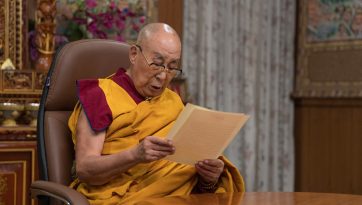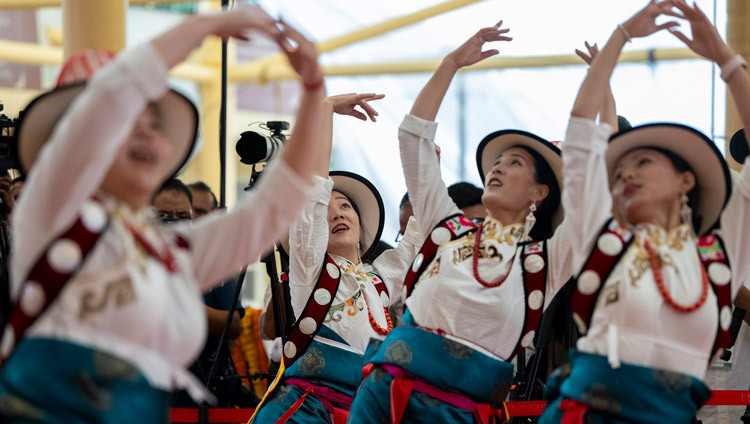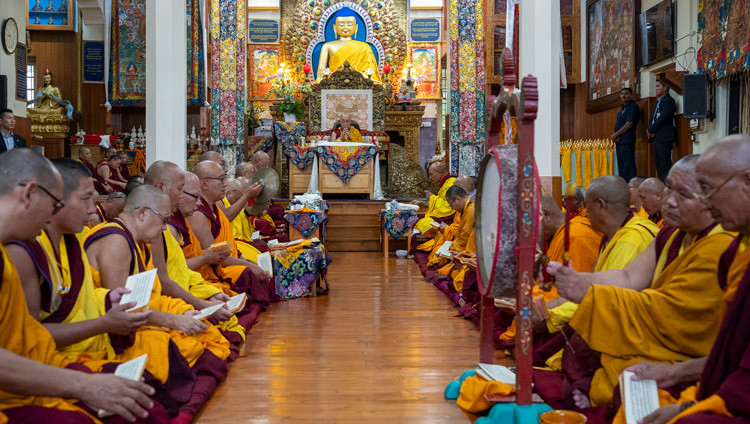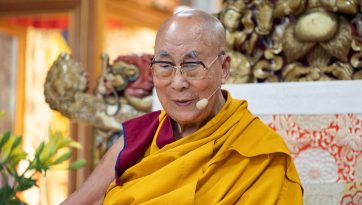Discourse on the Day of Offerings
Thekchen Chöling, Dharamsala, HP, India – The Tsuglagkhang, the Main Tibetan Temple, and the courtyard before it were packed this morning with an estimated 8000 people, Tibetans, people from the Himalayan region, and others from further afield. They had all gathered to hear His Holiness the Dalai Lama give his customary discourse on the ‘Day of Offerings’, the full-moon day of the first month of the Tibetan New Year and the culmination of the Great Prayer Festival.
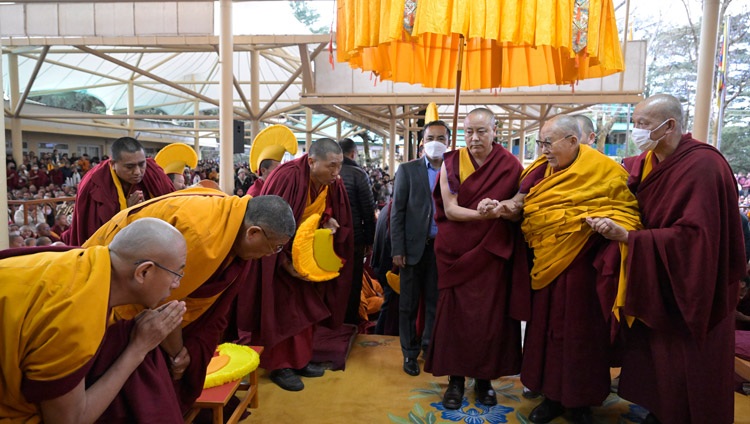
His Holiness the Dalai Lama walking through the Main Tibetan Temple courtyard on his way to give his teaching on the ‘Day of Offerings’ in Dharamsala, HP, India on February 24, 2024. Photo by Ven Zamling Norbu
His Holiness walked from the gate to his residence to the throne at the head of the courtyard, below the temple. He was preceded by monks playing the Tibetan horn known as gyaling and another swinging a censer. A monk walking behind him carried a large yellow ceremonial umbrella. To the left of the throne, when His Holiness took his seat, was a gathering of eminent monks and to the right sat members of the Central Tibetan Administration. On the table next to him was a white orchid in full bloom.
A chant-master led a recitation of the ‘Heart Sutra’ followed by verses of homage to the Buddha, Manjushri, Maitreya, Nagarjuna from Tsongkhapa’s ‘Concise Stages of the Path. Meanwhile, tea and sweet rice were served. The offering of a mandala and request for His Holiness teach was presented by Education Kalon Tharlam Dolma Changra followed by the Abbots of Gyutö and Namgyal Monasteries. The entire congregation joined together in chanting the verse for taking refuge and generating the awakening mind.
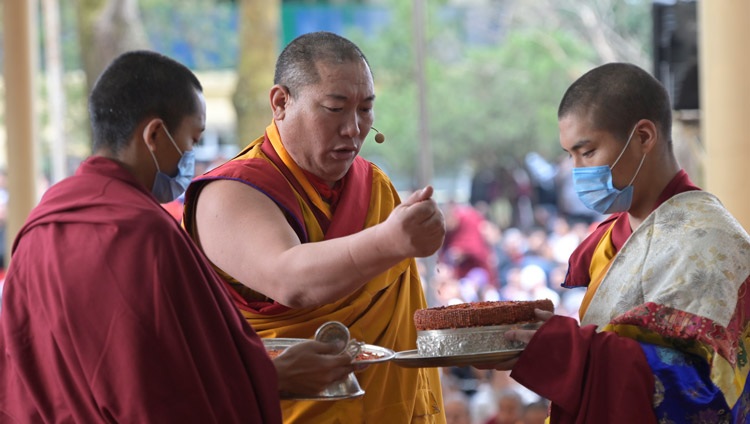
The Chant Master leading a mandala offering during His Holiness the Dalai Lama’s teaching on the ‘Day of Offerings’ at the Main Tibetan Temple courtyard in Dharamsala, HP, India on February 24, 2024. Photo by Ven Zamling Norbu
“So, today, we’re all gathered here in this courtyard for a Dharma discourse,” His Holiness declared. “In the world today an increasing number of people are taking an interest in inner development, especially those whose lives have been focused on materialistic concerns. They are taking an interest in training their minds.
“The theistic religious traditions are good, but what distinguishes Buddhism is its thorough understanding of the workings of the mind. This is what attracts the interest of scientists. Our approach to finding inner peace by training the mind is both realistic and scientific. This is a tradition that has been upheld in Tibet and the regions around it.
“I have friends with strong religious faith who seek peace of mind in their belief in a creator god. However, we believe we need to use our minds—to train our minds—to find inner peace. In the West there are people with no religious commitment paying attention to what the Buddha taught to reduce attachment and anger. Indeed, the primary antidote to anger is compassion.
“At the beginning of his work ‘Entering into the Middle Way’ the Indian master Chandrakirti pays homage to great compassion at the beginning of the path to enlightenment, in the middle and even at its fruition. Compassion provides a harvest of benefit.
“Compassion is crucial in our ordinary day-to-day lives. And in today’s world when people resort to violence and do harm to others compassion has an important mediating role.
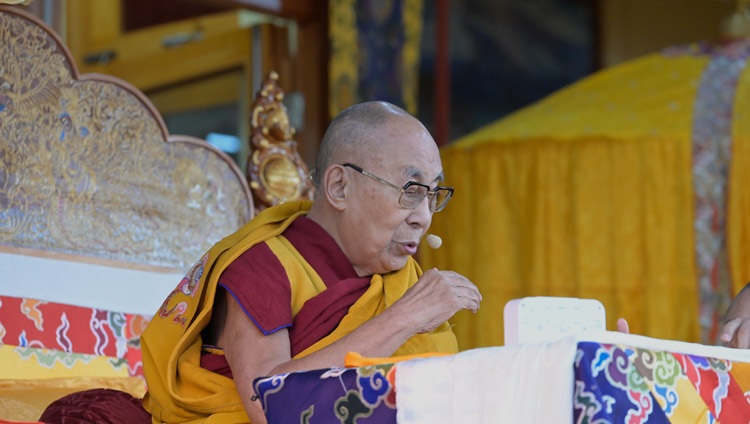
His Holiness the Dalai Lama addressing the congregation at the Main Tibetan Temple courtyard in Dharamsala, HP, India on February 24, 2024. Photo by Ven Zamling Norbu
“I make compassion my primary practice and combine it with an understanding of emptiness. This brings peace of mind, a state of mind undisturbed by afflictive emotions, which brings good health and leads to long life.”
His Holiness explained that the teaching of the Buddha that had come to Tibet from Nalanda University depends not on faith but on logic and reason. Part of it includes an understanding of the workings of the mind. He emphasised the importance of understanding the trouble emotions can cause.
His Holiness mentioned that Songtsen Gampo, the Tibetan religious king, must have been very determined. Although he had married a Chinese princess, when it came to selecting a model for a Tibetan script, he chose the Indian Devanagiri alphabet. Then, during the time of King Trisong Detsen, Shantarakshita was invited to Tibet. He introduced the rigorous study of works by Nalanda masters like Nagarjuna, the key to which is the use of logic and reason.
His Holiness stressed that the more you employ reason and logic, the deeper will be your understanding of the Buddha’s teaching. He reiterated that thinking through what you’ve learned over and over again is very powerful. The combination of study and analysis that underlies the Nalanda Tradition, he stated, is one of the world’s treasures.
“In a world facing great upheaval, it’s important to understand that anger, pride and arrogance are mentally disturbing. In many parts of the world there are people doing harm and hurting others. They could really benefit from teachings of compassion that are at the core of the tradition we have preserved. And we’ve kept this tradition alive by putting the teachings into practice. Our Chinese friends acknowledge that Tibetans are fundamentally good-hearted. Circumstances in the world may change, but peace of mind remains the same.
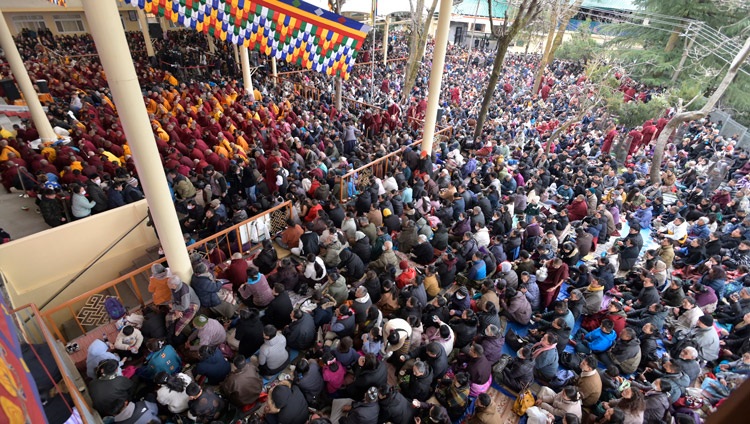
A view of the crowd of 8000 gathered at the main Tibetan Temple courtyard to attend the teachings of His Holiness the Dalai Lama in Dharamsala, HP, India on February 24, 2024. Photo by Ven Zamling Norbu
“We should try to explain our behaviour and values whenever we can. We have a tradition that gives rise to peace of mind, which is an essential factor if there is to be peace in the world. It’s important to recognise that when you’re overwhelmed by anger you have no peace within, but when you’re moved by love and compassion you do.
“I make the awakening mind of bodhichitta and an understanding of emptiness the very core of my practice. And, as I’ve said, it brings me peace of mind. I urge all of you to cultivate compassion and wisdom and base your own practice on warm-heartedness.
“Now, I would like to lead you through the All-Encompassing Yoga Mind, a practice I do every day which I think will be useful for you too. As human beings we are all the same. We all want to be happy not sad. We prefer to hear good news rather than bad. If you have a good heart, you’ll be popular, whereas if you’re proud and arrogant people will be reluctant to praise you.
“In ‘Entering into the Middle Way’ Chandrakirti pays homage to compassion at the outset because it is not only the seed of enlightenment, it’s also the water and soil that enable it to grow. I make compassion my primary practice because it brings me peace of mind and robust good health. Even animals appreciate compassion.
“As soon as I wake in the morning, I reflect on bodhichitta. Then I consider how things appear to be objectively existent, but when I think it through, I see that they don’t actually exist that way. I reflect on these principles every day.
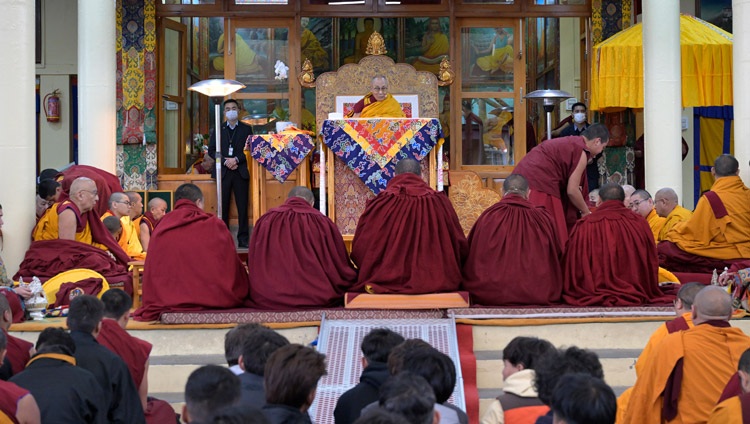
A view of the stage during the His Holiness the Dalai Lama’s teaching at the Main Tibetan Temple courtyard in Dharamsala, HP, India on February 24, 2024. Photo by Ven Zamling Norbu
“Let’s meditate on the awakening mind, the wish to be of real benefit to others. Bodhichitta is a factor helpful to others as well as yourself in the short and long term. Now imagine this good-hearted, altruistic mind transforming into a white moon disc at your heart.
“Next, recall how you think of yourself as this or that and the way you appear to your mind as having a solid, independent existence. When you seek and don’t find anything existing that way, you recognize that you exist only as a designation dependent on language and concepts. Now, imagine this understanding of emptiness of a solid, independent existence transforming into a white vajra standing on the moon disc at your heart.
“Realization doesn’t occur immediately, but will dawn if you practise steadily.”
His Holiness led the gathering in reciting the All-Encompassing Yoga Mind mantra: Om sarva yogachitta utpatayami. Then, to stabilize the disciples’ minds and make the mind of all-encompassing yoga firm, he asked them to recite after him: Om surate samaya satvam ho siddhi vajra yatha sukham
His Holiness then recited a verse in praise of Avalokiteshvara—Chenresig—and the six syllable mantra, Om mani padme hung.
Greatly praised by all the Buddhas,
You have accrued all noble qualities,
And you are named the Deity with an Unwinking Gaze,
I pay homage to you, the Everlastingly Compassionate One!
He followed this by reciting a praise to Manjushri and his mantra Om ara patsa na dhih.
I pay homage to Shri Manjugosha
Who bears a youthful form,
Is adorned by the lamp of wisdom
That dispels the darkness of the triple world.
Finally, as is customary on this Day of Offerings, His Holiness read one of the Jataka Tales that recall Buddha Shakyamuni’s previous lives. This story took place when the Bodhisattva was king of the Shibis. He encouraged his subjects to turn away from harm and embrace righteousness.
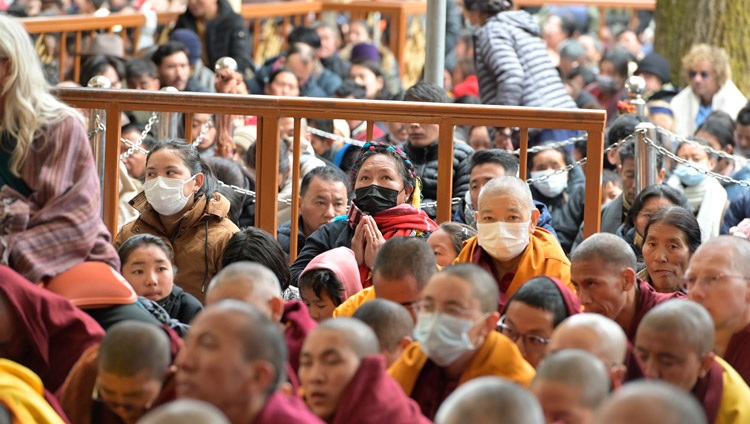
Members of the crowd listening to His Holiness the Dalai Lama teaching at the Main Tibetan Temple courtyard in Dharamsala, HP, India on February 24, 2024. Photo by Ven Zamling Norbu
It happened that there was an exceptionally attractive young woman in the kingdom. She was named Unmadayanti, `She Who Drives Men Mad’. Her father offered to marry her to the king, but he turned him down as his advisors recommended. She was then married to a member of the king’s court. However, when the king encountered her while driving through the city he fell madly in love.
Unmadayanti’s husband tried to persuade the king to accept her as his gift. But the king replied” “”No, that cannot be, and for what reasons? First, all my merit would be lost, and I am not immortal. Second, my wicked deed would inevitably become known to the public. And finally, when you were separated from your wife, you would burn with the fire of sorrow—a fire which would consume you as surely as flames consume dry grass.”
His Holiness chose to stop there for the day. A thanksgiving mandala was offered and prayers for the flourishing of the Dharma were said. Then, smiling and waving to the crowd on his way, His Holiness walked steadily, but unhurriedly, back to the palace gate, from where he rode in a golfcart up to his residence.

